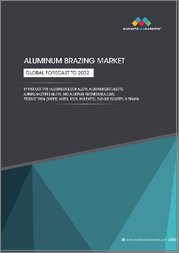
|
시장보고서
상품코드
1758717
납땜 합금 시장 규모, 점유율, 성장 분석 : 프로세스별, 기재별, 용도별, 최종사용자별, 지역별 - 산업 예측(2025-2032년)Braze Alloys Market Size, Share, and Growth Analysis, By Process (Torch Brazing, Furnace Brazing), By Base Material (Copper, Gold), By Application, By End-User, By Region - Industry Forecast 2025-2032 |
||||||
세계의 납땜 합금 시장 규모는 2023년에 35억 달러, 2024년 38억 1,000만 달러에서 2032년에는 75억 4,000만 달러로 성장하고, 예측 기간(2025-2032년) CAGR은 8.9%를 보일 전망입니다.
납땜 합금 시장은 자동차 및 HVAC 산업, 항공우주 제조 증가, 전자제품의 소형화 추세에 힘입어 크게 성장하고 있습니다. 이 합금은 HVAC 시스템 및 자동차 부품에 필수적인 우수한 강도와 누출 방지 특성으로 인해 선호되고 있습니다. 또한, 열 순환과 부식에 대한 내식성으로 인해 태양광 패널 및 풍력 터빈과 같은 재생에너지 인프라에도 필수적인 소재입니다. 제어된 대기 및 진공 환경에서의 납땜 기술 등의 발전으로 금속 접합의 효율성과 품질이 더욱 향상되고 있습니다. 그러나 원자재 가격 변동, 환경 문제, 대체 접합 기술의 부상과 같은 과제가 향후 시장 확대를 저해할 수 있습니다.
목차
서론
- 조사 목적
- 조사 범위
- 정의
조사 방법
- 정보 조달
- 2차·1차 데이터 방법
- 시장 규모 예측
- 시장 전제조건과 제한
주요 요약
- 세계 시장 전망
- 공급과 수요 동향 분석
- 부문별 기회 분석
시장 역학과 전망
- 시장 개요
- 시장 규모
- 시장 역학
- 성장 촉진요인과 기회
- 성장 억제요인과 과제
- Porter의 Five Forces 분석
주요 시장 인사이트
- 중요 성공 요인
- 경쟁 정도
- 주요 투자 기회
- 시장 생태계
- 시장의 매력 지수(2024년)
- PESTEL 분석
- 거시경제 지표
- 밸류체인 분석
- 가격 분석
- 사례 연구
납땜 합금 시장 규모 : 프로세스별, CAGR(2025-2032년)
- 시장 개요
- 토치 브레이징
- 용광로 브레이징
- 인덕션 브레이징
- 적외선 브레이징
- 기타
납땜 합금 시장 규모 : 기재별, CAGR(2025-2032년)
- 시장 개요
- 구리
- 금
- 알루미늄
- 기타
납땜 합금 시장 규모 : 용도별, CAGR(2025-2032년)
- 시장 개요
- 터빈
- 열교환기
- 서브 어셈블리 센서
- 기타
납땜 합금 시장 규모 : 최종사용자별, CAGR(2025-2032년)
- 시장 개요
- 항공우주 및 방위
- 전기 및 전자 공학
- 건설
- 기타
납땜 합금 시장 규모 : 지역별, CAGR(2025-2032년)
- 북미
- 미국
- 캐나다
- 유럽
- 독일
- 스페인
- 프랑스
- 영국
- 이탈리아
- 기타 유럽
- 아시아태평양
- 중국
- 인도
- 일본
- 한국
- 기타 아시아태평양
- 라틴아메리카
- 브라질
- 기타 라틴아메리카
- 중동 및 아프리카
- GCC 국가
- 남아프리카
- 기타 중동 및 아프리카
경쟁 정보
- 주요 5개사 비교
- 주요 기업의 시장 포지셔닝(2024년)
- 주요 시장 기업이 채택한 전략
- 최근 시장 동향
- 기업의 시장 점유율 분석(2024년)
- 주요 기업 개요
- 기업 상세
- 제품 포트폴리오 분석
- 기업 부문별 점유율 분석
- 매출 전년대비 비교(2022-2024년)
주요 기업 개요
- Johnson Matthey
- Voestalpine Bohler Welding
- Oerlikon Metco
- UMICORE N.V.
- Morgan Advanced Materials
- Paras Enterprise
- Lucas-Milhaupt Inc.
- Bellman-Melcor
- Aimtek, Inc.
- VBC Group
- Cupro Alloys Corporation
- OC Oerlikon Management AG
- Saru Silver Alloy Private Limited
- Saxonia Edelmetalle GmbH
- Sulzer Ltd
- The Harris Products Group
결론과 제안
LSH 25.07.04Global Braze Alloys Market size was valued at USD 3.5 billion in 2023 and is poised to grow from USD 3.81 billion in 2024 to USD 7.54 billion by 2032, growing at a CAGR of 8.9% during the forecast period (2025-2032).
The braze alloys market is experiencing significant growth fueled by robust demand from the automotive and HVAC sectors, increased aerospace manufacturing, and trends towards miniaturization in electronics. These alloys are favored for their superior strength and resistance to leaks, crucial for HVAC systems and automotive components. Additionally, they are vital in renewable energy infrastructures, including solar panels and wind turbines, due to their ability to withstand thermal cycling and corrosion. Advances in brazing techniques, such as controlled atmosphere and vacuum brazing, have further improved the efficiency and quality of metal joins. However, challenges such as raw material price volatility, environmental concerns, and the emergence of alternative joining technologies may hinder market expansion going forward.
Top-down and bottom-up approaches were used to estimate and validate the size of the Global Braze Alloys market and to estimate the size of various other dependent submarkets. The research methodology used to estimate the market size includes the following details: The key players in the market were identified through secondary research, and their market shares in the respective regions were determined through primary and secondary research. This entire procedure includes the study of the annual and financial reports of the top market players and extensive interviews for key insights from industry leaders such as CEOs, VPs, directors, and marketing executives. All percentage shares split, and breakdowns were determined using secondary sources and verified through Primary sources. All possible parameters that affect the markets covered in this research study have been accounted for, viewed in extensive detail, verified through primary research, and analyzed to get the final quantitative and qualitative data.
Global Braze Alloys Market Segments Analysis
Global Braze Alloys Market is segmented by Process, Base Material, Application, End-User and region. Based on Process, the market is segmented into Torch Brazing, Furnace Brazing, Induction Brazing, Infrared brazing and Others. Based on Base Material, the market is segmented into Copper, Gold, Aluminum and Others. Based on Application, the market is segmented into Turbines, Heat Exchangers, Sub-Assembly Sensors and Others. Based on End-User, the market is segmented into Aerospace and Defense, Electrical and Electronics, Construction and Others. Based on region, the market is segmented into North America, Europe, Asia Pacific, Latin America and Middle East & Africa.
Driver of the Global Braze Alloys Market
The global braze alloys market is significantly propelled by the aerospace industry, which requires precise connections between components crafted from various metals to meet stringent performance criteria. Braze alloys are essential for their durability, high-temperature resistance, and structural integrity, which are crucial for applications in turbine engines, airframes, and fuel systems. As commercial aviation experiences growth and upgrades in military aircraft continue, alongside increased investments in space exploration, the demand for braze alloys is expected to flourish, positively impacting market trajectories through 2032 and enhancing the overall market outlook.
Restraints in the Global Braze Alloys Market
The Global Braze Alloys market faces significant constraints due to its dependence on precious and non-ferrous metals such as silver, nickel, and copper. The prices of these essential raw materials are subject to volatility caused by supply chain disruptions, geopolitical tensions, and varying mining production levels. Such price instability leads to increased production costs, adversely impacting profit margins for manufacturers. This challenge is particularly pronounced for small- and medium-sized enterprises, which often find it difficult to secure a consistent supply or transfer the heightened costs to consumers. Consequently, this situation hampers the market penetration and growth potential of braze alloys.
Market Trends of the Global Braze Alloys Market
The Global Braze Alloys market is witnessing a significant trend towards the adoption of eco-friendly and flux-free brazing alloys, spurred by stringent environmental regulations and a growing emphasis on sustainability. Industries are increasingly favoring cadmium-free and lead-free alternatives that not only minimize toxic emissions but also eliminate the requirement for post-brazing cleaning, thereby reducing operational costs and enhancing environmental compliance. This movement is particularly evident in Europe and North America, where manufacturers are pivoting towards lead-free and low-temperature brazing materials to align with sustainable manufacturing practices. As a result, the demand for these eco-conscious solutions is expected to continue rising in the coming years.
Table of Contents
Introduction
- Objectives of the Study
- Scope of the Report
- Definitions
Research Methodology
- Information Procurement
- Secondary & Primary Data Methods
- Market Size Estimation
- Market Assumptions & Limitations
Executive Summary
- Global Market Outlook
- Supply & Demand Trend Analysis
- Segmental Opportunity Analysis
Market Dynamics & Outlook
- Market Overview
- Market Size
- Market Dynamics
- Drivers & Opportunities
- Restraints & Challenges
- Porters Analysis
- Competitive rivalry
- Threat of substitute
- Bargaining power of buyers
- Threat of new entrants
- Bargaining power of suppliers
Key Market Insights
- Key Success Factors
- Degree of Competition
- Top Investment Pockets
- Market Ecosystem
- Market Attractiveness Index, 2024
- PESTEL Analysis
- Macro-Economic Indicators
- Value Chain Analysis
- Pricing Analysis
- Case Studies
Global Braze Alloys Market Size by Process & CAGR (2025-2032)
- Market Overview
- Torch Brazing
- Furnace Brazing
- Induction Brazing
- Infrared brazing
- Others
Global Braze Alloys Market Size by Base Material & CAGR (2025-2032)
- Market Overview
- Copper
- Gold
- Aluminum
- Others
Global Braze Alloys Market Size by Application & CAGR (2025-2032)
- Market Overview
- Turbines
- Heat Exchangers
- Sub-Assembly Sensors
- Others
Global Braze Alloys Market Size by End-User & CAGR (2025-2032)
- Market Overview
- Aerospace and Defense
- Electrical and Electronics
- Construction
- Others
Global Braze Alloys Market Size & CAGR (2025-2032)
- North America (Process, Base Material, Application, End-User)
- US
- Canada
- Europe (Process, Base Material, Application, End-User)
- Germany
- Spain
- France
- UK
- Italy
- Rest of Europe
- Asia Pacific (Process, Base Material, Application, End-User)
- China
- India
- Japan
- South Korea
- Rest of Asia-Pacific
- Latin America (Process, Base Material, Application, End-User)
- Brazil
- Rest of Latin America
- Middle East & Africa (Process, Base Material, Application, End-User)
- GCC Countries
- South Africa
- Rest of Middle East & Africa
Competitive Intelligence
- Top 5 Player Comparison
- Market Positioning of Key Players, 2024
- Strategies Adopted by Key Market Players
- Recent Developments in the Market
- Company Market Share Analysis, 2024
- Company Profiles of All Key Players
- Company Details
- Product Portfolio Analysis
- Company's Segmental Share Analysis
- Revenue Y-O-Y Comparison (2022-2024)
Key Company Profiles
- Johnson Matthey
- Company Overview
- Business Segment Overview
- Financial Updates
- Key Developments
- Voestalpine Bohler Welding
- Company Overview
- Business Segment Overview
- Financial Updates
- Key Developments
- Oerlikon Metco
- Company Overview
- Business Segment Overview
- Financial Updates
- Key Developments
- UMICORE N.V.
- Company Overview
- Business Segment Overview
- Financial Updates
- Key Developments
- Morgan Advanced Materials
- Company Overview
- Business Segment Overview
- Financial Updates
- Key Developments
- Paras Enterprise
- Company Overview
- Business Segment Overview
- Financial Updates
- Key Developments
- Lucas-Milhaupt Inc.
- Company Overview
- Business Segment Overview
- Financial Updates
- Key Developments
- Bellman-Melcor
- Company Overview
- Business Segment Overview
- Financial Updates
- Key Developments
- Aimtek, Inc.
- Company Overview
- Business Segment Overview
- Financial Updates
- Key Developments
- VBC Group
- Company Overview
- Business Segment Overview
- Financial Updates
- Key Developments
- Cupro Alloys Corporation
- Company Overview
- Business Segment Overview
- Financial Updates
- Key Developments
- OC Oerlikon Management AG
- Company Overview
- Business Segment Overview
- Financial Updates
- Key Developments
- Saru Silver Alloy Private Limited
- Company Overview
- Business Segment Overview
- Financial Updates
- Key Developments
- Saxonia Edelmetalle GmbH
- Company Overview
- Business Segment Overview
- Financial Updates
- Key Developments
- Sulzer Ltd
- Company Overview
- Business Segment Overview
- Financial Updates
- Key Developments
- The Harris Products Group
- Company Overview
- Business Segment Overview
- Financial Updates
- Key Developments

















